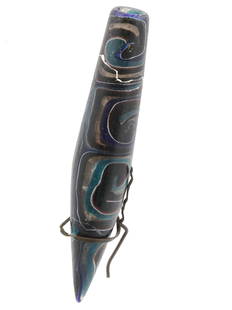
Late Hellenistic / Early Roman Glass Mosaic Alabastron
Similar Sale History

Recommended Items






Item Details
Description
Late Hellenistic / Early Roman Imperial Period, ca. 1st century BCE to 1st century CE. A stunning translucent alabastron formed with amber-hued glass with multiple strands of opaque white glass. The alabastron, likely used to contain perfumes and other scented oils, has an elongated cylindrical form with a conical base, a thick unpronounced rim, and a raised discoid guard which delineates the neck. Its elegant presentation and opulent color suggest this vessel was used by a woman of high status, meant to be taken to the bath houses and used as part of their toiletries. Covered in faint layers of rainbow-hued iridescence, this is a marvelous work of glass art to be treasured for its impeccable form, beautiful hues, and sophisticated technique. Custom museum-quality display stand included. Size: 1" W x 5.75" H (2.5 cm x 14.6 cm); 6.75" H (17.1 cm) on included custom stand.
The alabastron is a long-bodied vessel, typically with a rounded bottom, a cylindrical neck, and a flat disk for a mouth. Though usually without handles, some alabastra have eyes, lugs, or disc-shaped guards like this example. According to the Beazley Archive of the University of Oxford, the alabastron shape's history extends back to Corinth, but was only preserved in Athenian pottery examples back to the mid-sixth century BCE. Alabastra were created in many materials, including alabaster, and the Greek term for this stone - alabastron (most likely of Egyptian origin) - was the source of inspiration for the name of this shaped vessel. Many examples were finished with a white ground, as if to imitate this stone. We know from vase painting imagery of women using alabastra following a bath, that these vessels most likely held perfumed oils.
For a Hellenistic example exhibiting the same style of mosaic glass, please see The Metropolitan Museum of Art, accession number 91.1.1303: https://www.metmuseum.org/art/collection/search/245691
For an example of the same mosaic glass style from the early Roman Imperial period, please see The Metropolitan Museum of Art, accession number 91.1.1643: https://www.metmuseum.org/art/collection/search/256995
Provenance: private New York, USA collection
All items legal to buy/sell under U.S. Statute covering cultural patrimony Code 2600, CHAPTER 14, and are guaranteed to be as described or your money back.
A Certificate of Authenticity will accompany all winning bids.
We ship worldwide to most countries and handle all shipping in-house for your convenience.
#134582
The alabastron is a long-bodied vessel, typically with a rounded bottom, a cylindrical neck, and a flat disk for a mouth. Though usually without handles, some alabastra have eyes, lugs, or disc-shaped guards like this example. According to the Beazley Archive of the University of Oxford, the alabastron shape's history extends back to Corinth, but was only preserved in Athenian pottery examples back to the mid-sixth century BCE. Alabastra were created in many materials, including alabaster, and the Greek term for this stone - alabastron (most likely of Egyptian origin) - was the source of inspiration for the name of this shaped vessel. Many examples were finished with a white ground, as if to imitate this stone. We know from vase painting imagery of women using alabastra following a bath, that these vessels most likely held perfumed oils.
For a Hellenistic example exhibiting the same style of mosaic glass, please see The Metropolitan Museum of Art, accession number 91.1.1303: https://www.metmuseum.org/art/collection/search/245691
For an example of the same mosaic glass style from the early Roman Imperial period, please see The Metropolitan Museum of Art, accession number 91.1.1643: https://www.metmuseum.org/art/collection/search/256995
Provenance: private New York, USA collection
All items legal to buy/sell under U.S. Statute covering cultural patrimony Code 2600, CHAPTER 14, and are guaranteed to be as described or your money back.
A Certificate of Authenticity will accompany all winning bids.
We ship worldwide to most countries and handle all shipping in-house for your convenience.
#134582
Condition
Spout above discoid guard repaired from a few large pieces with light adhesive residue along break lines. Surface wear and abrasions commensurate with age, some minor pitting holes, and light roughness across most surfaces. Light earthen deposits and scattered areas of nice rainbow iridescence throughout.
Buyer's Premium
- 24.5%
Late Hellenistic / Early Roman Glass Mosaic Alabastron
Estimate $2,500 - $3,500
7 bidders are watching this item.
Shipping & Pickup Options
Item located in Louisville, CO, usSee Policy for Shipping
Payment

Related Searches
TOP

















































